Sweet Corn
European corn borer (ECB) moth captures remain scattered and very low, and no map will appear in this addition. There are very few plantings not yet silking. Silk sprays for corn earworm (CEW) control will serve to manage ECB larvae as well. Reminder: Useful insecticides for worm control in the silk stage include spinosyns (including OMRI approved Entrust) IRAC Grp 5), and diamides such as Coragen (IRAC Grp 28) or materials such as Besiege which include the active ingredient in Coragen. Synthetic pyrethroids alone should NOT be used for corn earworm (CEW) protection on silking corn. Control with these materials is very inconsistent.
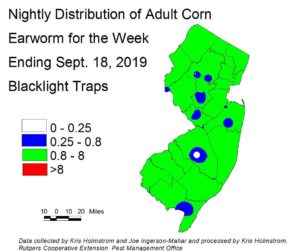 Corn earworm (CEW) moth catches have changed little in NJ this past week. Overall, CEW numbers represent a normal late summer population. While moth counts will decline somewhat with cool night temperatures, look for strong rebounds when nighttime temperatures exceed 60F. The green area on the blacklight map (left) represents a 3-day silk spray schedule zone. Blue and white areas within the overall green zone are outliers, and corn growers in or near those areas should also adhere to 3-day silk spray schedules. Economically damaging populations of this pest are present throughout the state, and all areas are at extreme risk of crop injury if strict silk spray schedules are not observed. Red areas on the on the pheromone trap map (below at right) indicate a 3-day silk
Corn earworm (CEW) moth catches have changed little in NJ this past week. Overall, CEW numbers represent a normal late summer population. While moth counts will decline somewhat with cool night temperatures, look for strong rebounds when nighttime temperatures exceed 60F. The green area on the blacklight map (left) represents a 3-day silk spray schedule zone. Blue and white areas within the overall green zone are outliers, and corn growers in or near those areas should also adhere to 3-day silk spray schedules. Economically damaging populations of this pest are present throughout the state, and all areas are at extreme risk of crop injury if strict silk spray schedules are not observed. Red areas on the on the pheromone trap map (below at right) indicate a 3-day silk 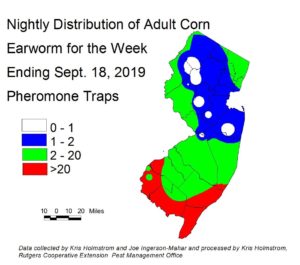 spray schedule, while green indicates a 4-5 day silk spray schedule. Currently, the black light network is indicating a more conservative spray regime statewide, than is the pheromone network. Taken together, blacklight and pheromone traps are indicating 3-day silk spray schedules throughout the state. There are far fewer CEW pheromone traps than blacklights, and the resulting map has much broader color bands as a result. It should also be noted that the pheromone traps are much more sensitive than blacklights. Therefore, the number of moths caught in pheromone traps required to generate a specific spray interval is much higher than the number caught in blacklight traps. It must be stressed that there is high variability in these catches, and growers should consult with their IPM practitioner on recommended spray schedules.
spray schedule, while green indicates a 4-5 day silk spray schedule. Currently, the black light network is indicating a more conservative spray regime statewide, than is the pheromone network. Taken together, blacklight and pheromone traps are indicating 3-day silk spray schedules throughout the state. There are far fewer CEW pheromone traps than blacklights, and the resulting map has much broader color bands as a result. It should also be noted that the pheromone traps are much more sensitive than blacklights. Therefore, the number of moths caught in pheromone traps required to generate a specific spray interval is much higher than the number caught in blacklight traps. It must be stressed that there is high variability in these catches, and growers should consult with their IPM practitioner on recommended spray schedules.
The highest nightly CEW pheromone trap catches for the week ending 9/18/19 are as follows:
| Green Creek 129 | Berlin 17 | Springdale 9 | East Vineland 3 |
| Beckett 62 | Woodstown 17 | Pedricktown 6 | Monroeville 3 |
| Eldora 56 | Snyder Farm 15 | Folsom 5 | Matawan 2 |
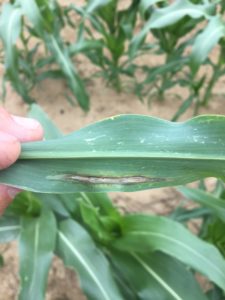 Northern corn leaf blight (NCLB) presence continues in northern NJ sweet corn plantings, and may be present elsewhere. This disease causes elongated gray lesions, starting on older foliage (see photo at left). If uncontrolled, NCLB can result in enough foliage loss to limit ear size, as well as forming lesions on the husk leaves. Growers should be scouting for this disease when checking for insect injury. Control is necessary if lesions appear while plants are in the whorl stage. Heavier dew periods, common throughout September, favor disease development. Fungicides in FRAC groups 3, 7 and 11 are labled for control of this disease in rotation with chlorothalonil. See the 2019 Commercial Vegetable Production Guide for suggested materials.
Northern corn leaf blight (NCLB) presence continues in northern NJ sweet corn plantings, and may be present elsewhere. This disease causes elongated gray lesions, starting on older foliage (see photo at left). If uncontrolled, NCLB can result in enough foliage loss to limit ear size, as well as forming lesions on the husk leaves. Growers should be scouting for this disease when checking for insect injury. Control is necessary if lesions appear while plants are in the whorl stage. Heavier dew periods, common throughout September, favor disease development. Fungicides in FRAC groups 3, 7 and 11 are labled for control of this disease in rotation with chlorothalonil. See the 2019 Commercial Vegetable Production Guide for suggested materials.
Corn leaf aphid populations have been a problem in late sweet corn. 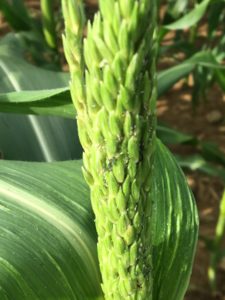 These aphids (photo at right) may be found in the emerged tassel while scouting for other insects. These insects are not controlled with IRAC group 5 or 28 insecticides, and pyrethroids are ineffective at killing aphids but very good at killing beneficial insects. Therefore, if corn leaf aphids are found in tassels, it is advisable to add the IRAC group 4a material Assail in with the first silk application for worm control.
These aphids (photo at right) may be found in the emerged tassel while scouting for other insects. These insects are not controlled with IRAC group 5 or 28 insecticides, and pyrethroids are ineffective at killing aphids but very good at killing beneficial insects. Therefore, if corn leaf aphids are found in tassels, it is advisable to add the IRAC group 4a material Assail in with the first silk application for worm control.
Silking Spray Schedules*:
South – 3 days
Central – 3 days
North – 3-4 days
*These recommendations are based on regional catches. Adhere to tighter spray schedules if indicated by local trap catches. To repeat: Synthetic pyrethroids alone should NOT be used for corn earworm (CEW) protection on silking corn, or for fall armyworm (FAW) management at any stage. Control with these materials is very inconsistent.
Peppers
Pepper weevil
Another farm in the Swedesboro area has reported having a disastrous infestation of weevils, where no peppers were harvested. It must be emphasized that when you are growing peppers in high risk areas near processing plants or landfills, strategic placement of pheromone traps is critical. When you go to harvest the first pick and discover that
there are no harvestable fruit, its too late to do anything about the weevils.
To repeat: Areas near food processing plants and land fills, especially those that accept vegetative waste are high risk areas for pepper plantings. Ideally, fields should be at least 1 mile from these facilities, or more. In these higher risk areas yellow sticky cards with pheromone lures should be deployed on the pepper field borders in the early growing season to help detect the presence of weevils.
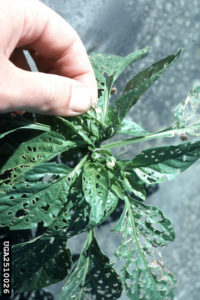 Pheromone traps established for beet armyworm (BAW) in the southern counties continue catching adults. This week’s average nightly catches include: Jones Island – 71, Pedricktown – 34, East Vineland – 16, Folsom – 6.
Pheromone traps established for beet armyworm (BAW) in the southern counties continue catching adults. This week’s average nightly catches include: Jones Island – 71, Pedricktown – 34, East Vineland – 16, Folsom – 6.
BAW can reach levels that result in damage to pepper plants, and injury has been reported in southwestern NJ. Growers in the southern counties should be alert for the appearance of severely defoliated terminals (see photo above at left) on pepper plants. Small BAW larvae (photo at right) feed on these leaves before turning to fruit as they increase in size. As with FAW, beet armyworm is resistant to pyrethroid insecticides. Insecticides now recommended for CEW and FAW control are useful for BAW management.
Tomatoes
With CEW numbers moderately high, tomato growers should be alert to the possibility of fruitworm injury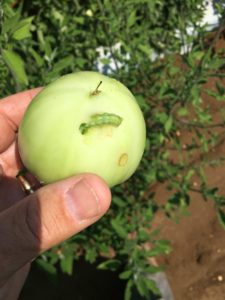 (see photo at right). CEW moths are attracted to blossom clusters in the upper canopy of plants. They lay eggs there, and larvae penetrate the nearest fruit without feeding on foliage. Thus, injury typically occurs on fruit in the upper and outer edges of the plant. With current CEW pheromone trap catch levels in southern New Jersey, it may be wise to treat preventively for this pest until numbers subside. If scouting, growers should consider an application to limit damage when the first sign of injury occurs. Insecticides in the IRAC group 28 (Coragen, etc.) and group 5 (Radiant, Entrust) are good
(see photo at right). CEW moths are attracted to blossom clusters in the upper canopy of plants. They lay eggs there, and larvae penetrate the nearest fruit without feeding on foliage. Thus, injury typically occurs on fruit in the upper and outer edges of the plant. With current CEW pheromone trap catch levels in southern New Jersey, it may be wise to treat preventively for this pest until numbers subside. If scouting, growers should consider an application to limit damage when the first sign of injury occurs. Insecticides in the IRAC group 28 (Coragen, etc.) and group 5 (Radiant, Entrust) are good 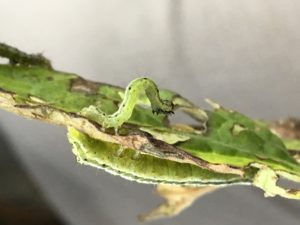 choices, as they are effective against CEW and are less toxic to beneficial insects. The use of synthetic pyrethroids (IRAC 3) can increase aphid and mite populations. In addition, late season populations of soybean looper are beginning to show up in some plantings. This caterpillar resembles cabbage looper, except that it has some dark markings on it’s sides, and has dark true legs (see photo at left). Soybean loopers will damage green fruit as well as foliage, and have been a problem in some northern counties in recent years.
choices, as they are effective against CEW and are less toxic to beneficial insects. The use of synthetic pyrethroids (IRAC 3) can increase aphid and mite populations. In addition, late season populations of soybean looper are beginning to show up in some plantings. This caterpillar resembles cabbage looper, except that it has some dark markings on it’s sides, and has dark true legs (see photo at left). Soybean loopers will damage green fruit as well as foliage, and have been a problem in some northern counties in recent years.
Pumpkins and Winter Squash
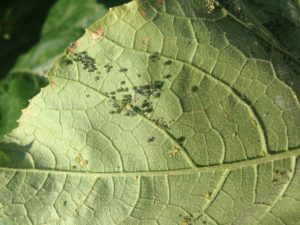 This is the time of the season when melon aphid (see photo at left) can appear in pumpkin fields. While this pest generally does not negatively impact yield this late in the season, large populations can cause cosmetic injury by depositing sticky droppings on developing fruit. A secondary fungus (sooty mold) grows on this substrate. Additionally, the sweet aphid droppings can attract hornets. This is a problem particularly in fields that are to be opened for U-pick customers. Recommended insecticides may be found in the 2019 Commercial Vegetable Production Guide, with several including Fulfill and Beleaf being much less toxic to bees. Consider treating if melon aphid colonies are found in more than one site in a ten site sample.
This is the time of the season when melon aphid (see photo at left) can appear in pumpkin fields. While this pest generally does not negatively impact yield this late in the season, large populations can cause cosmetic injury by depositing sticky droppings on developing fruit. A secondary fungus (sooty mold) grows on this substrate. Additionally, the sweet aphid droppings can attract hornets. This is a problem particularly in fields that are to be opened for U-pick customers. Recommended insecticides may be found in the 2019 Commercial Vegetable Production Guide, with several including Fulfill and Beleaf being much less toxic to bees. Consider treating if melon aphid colonies are found in more than one site in a ten site sample.
Cole Crops
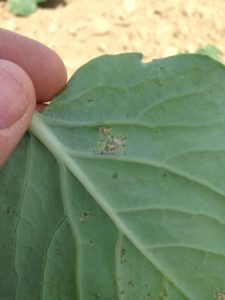 As we approach the fall growing season, acreage of all types of cole crops is increasing. Be aware that beside the usual caterpillar pest problems, there are diseases to contend. Downy mildew (photo at left) is a common problem in collards, especially. Yellow lesions form on the upper surface of leaves, and sparse, whitish sporulation may be found on the underside of affected leaves. Broccoli is also commonly impacted by this disease as the weather cools and dews become
As we approach the fall growing season, acreage of all types of cole crops is increasing. Be aware that beside the usual caterpillar pest problems, there are diseases to contend. Downy mildew (photo at left) is a common problem in collards, especially. Yellow lesions form on the upper surface of leaves, and sparse, whitish sporulation may be found on the underside of affected leaves. Broccoli is also commonly impacted by this disease as the weather cools and dews become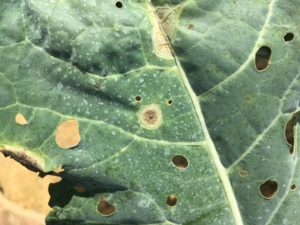 heavier. Alternaria (photo at right) is also an increasingly common disease of cole crops at this time of year. Alternaria can become a serious problem on broccoli heads, and double cropping cole crops can make this situation more severe. Be sure to incorporate all crop residue into soil as soon as the crop is harvested. See the 2019 Commercial Vegetable Production Guide for recommended materials to manage crucifer downy mildew and alternaria.
heavier. Alternaria (photo at right) is also an increasingly common disease of cole crops at this time of year. Alternaria can become a serious problem on broccoli heads, and double cropping cole crops can make this situation more severe. Be sure to incorporate all crop residue into soil as soon as the crop is harvested. See the 2019 Commercial Vegetable Production Guide for recommended materials to manage crucifer downy mildew and alternaria.
Imported cabbageworms (ICW) and diamondback moth larvae (DBM) are hitting late summer cole crop plantings. Be sure to scout weekly, and treat plantings if heading type crops (cabbage, broccoli, cauliflower) are 10% or more infested in the 0-9 true leaf stage, 20% infested from 9-pre head, and 5% with heads forming. Leafy types like collards and kale should be treated whenever the 10% plants infested threshold is reached. Remember that DBM is resistant to pyrethroid insecticides. Reliable DBM control is achieved with spynosins (IRAC 5) or IRAC 28 materials like Coragen.
Brown Marmorated Stink Bug (BMSB)
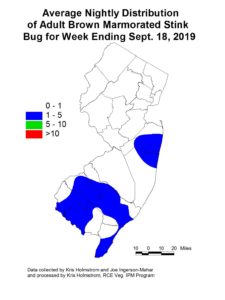 BMSB activity in black light traps remained steady over the past week (See BMSB map at left). Black light catches are likely a better indicator of stink bug activity (movement) than of actual numbers in a given area. Growers with crops that are potential targets of this pest should be scouting for BMSB or increases in stink bug injury.
BMSB activity in black light traps remained steady over the past week (See BMSB map at left). Black light catches are likely a better indicator of stink bug activity (movement) than of actual numbers in a given area. Growers with crops that are potential targets of this pest should be scouting for BMSB or increases in stink bug injury.
The highest nightly catches of BMSB in black light traps for the week ending 9/18/19 are as follows:
| Farmingdale 5 | Elm 2 | Pedricktown 1 |
| Green Creek 3 | East Vineland 1 | Sergeantsville 1 |
| Centerton 2 | New Egypt 1 | Springdale 1 |
| Downer 2 | Old Bridge 1 | Woodstown 1 |

